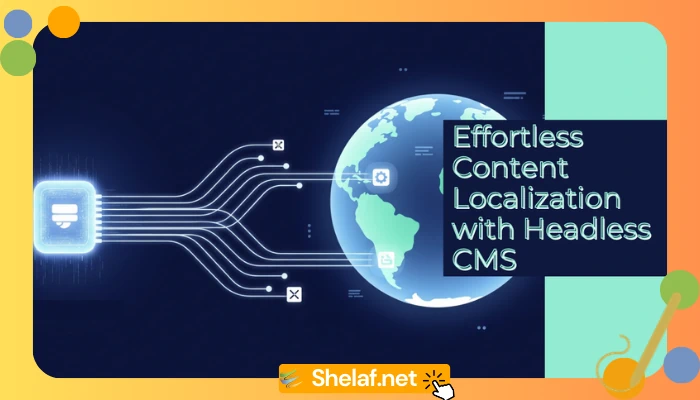Content localization has become a crucial component of engagement with customers and brand success for companies going global. Translation is no longer a mechanical, word-for-word process; in an increasingly globalized world, audiences expect information sent to them in their language literal, figurative, cultural, regional, intentional. Yet as much as humans can attempt to create translations accommodating all expectations and all audiences, it falls short; scalable, technology-driven, multimodal processes are required.
Therefore, the future of localization processes within the headless CMS framework will fulfill such expectations. The headless CMS solution offers a content structure, API integration potential, and decoupled delivery for rapid, accurate, and intentional localization on a larger scale. Yet leveraging these solutions to their full potential depends on certain guidelines for successful localization.
Contents
Localization Readiness Happens at the Content Model Level
The best way to ensure effective localization workflow is to consider it at the content model level. The more content is rigid, distinct fields for headlines, body copy, calls to action, product descriptions, metadata the easier it is to understand what’s required to be translated and what can stay as-is. In a headless CMS, for example, easier export of content and re-import post localization without changing page renderings or hard-coded templates exists. Storyblok events often showcase real-world examples of how brands implement these localization workflows successfully. Therefore, the easier it is to localize from the start, brands won’t have to change the content structure down the line to support localization, which saves time and reduces technical debt.
Linked Variants Allow for More Effective Language Management
Managing regions and multiple languages is easier when segmented through linked variants. With a headless CMS, you can create each piece of content with linked versions that are culturally appropriate to the master. This allows for global version control to understand what’s modified to the master and how many variants it has, giving teams visibility into what’s localized, what’s in-progress and what’s planned for translation. This version control ensures global and regional efforts are kept in one central location without any loss of visibility for any messaging efforts.
Systems Integrate to Automate Localization Efforts
Sending out spreadsheets for translations or copy/pasting text into a translation platform only creates human-error challenges and slows time to market. One of the biggest benefits of a headless CMS is its innate ability to easily integrate with a Translation Management Systems (TMS) or other language services providers. These APIs or plug-ins help with the physical sending of content to a TMS/language provider for translation, sending translation back to the CMS and for review within context. This increases time to market for localization solutions where human error is decreased and campaigns can go live faster in accurate languages.
Adding QA to the Localization Process
Maintaining brand voice, tone and compliance across localized content is essential. One of the headless CMS workflow best practices is to incorporate review checkpoints for not only linguistic QA but also cultural relevance, formatting and compliance sign-off. Role-based permissions provide language managers, legal and branding managers the opportunity to review critical aspects of the project before going live. By treating localization as an initiative that deserves the same quality output as English content rather than merely a translation, brands see greater value across all international deliverables.
Giving Local Teams Authority with Global Oversight
Localization must not sacrifice global compliance and quality for regional needs; a headless CMS allows for all to coexist. With role and permission capabilities for central and regional teams, for example, local marketers can edit and approve region-based content while still getting templated suggestions. The global team can lock in specific brand assets and key messaging so they do not get tampered with. This collaborative workflow allows local teams to move more quickly with better cultural relevance without jeopardizing compliance and quality across all markets.
Managing Multilingual SEO Metadata and Beyond
In many cases, localization goes beyond just body copy to SEO metadata, alt text, URL slugs and schema markup. A headless CMS offers the opportunity to ensure that these fields are properly managed for multilingual and multicultural use. SEO elements can have their own fields created in the content model so that localization can occur at the same time as body copy. This ensures that every page is properly set up for regional search engines at the time of publishing as long as hreflang is properly applied and the SEO meta fields are localized.
Ability to Preview and Review in Context Before Launch
Nothing is more important for accuracy and UX than knowing how the localized content will appear in context. The headless CMS allows marketers and translators to preview content before it goes live and in its intended configuration. Previewing ensures that the translated content does not exceed designed boxes, that formatting sticks, and that the message makes sense in the translated language. Previewing prevents having to backtrack or employing retroactive fixes post-implementation, which saves time and frustration and restores trust in the localization process.
Ability to Create a Feedback Loop to Further Improve Localization Efforts
The best localization workflows allow for learnings and adjustments. By monitoring how well efforts did post-translation bounce rates, conversions, engagement teams can understand what works where. A headless CMS integrates with various analytic offerings to assess performance by region; thus, post-performance can be evaluated after the fact. Additionally, learnings can be fed back in from regional teams and translators who may have insights into what may work better and where their feedback can improve template align translation efforts in the future.
Opportunity to Scale Localization Across Channels and Devices
Localization is necessary across any and all touchpoints including websites, mobile applications, emails, and digital products. The headless CMS allows for this, as any content can be repurposed and sent to any frontend via APIs. Once something is stuck and localized, it can then be pushed to any and all relevant channels in real-time, affording a new level of scalability, accessibility, and consistency. Furthermore, if new channels pop up (chatbots, voice activation, etc.), the content does not need to be remapped or rewritten; assets will conform through the same channels without additional work.
Avoiding Redundancy Through Content Reuse and Componentization
Localization can become redundant through the constant rehashing of the same efforts; duplicating efforts works against low operational costs and quick turnaround times. A headless CMS helps avoid redundancy by allowing content to become componentized and repurposed by markets that leverage other formats or only need slight adjustments. For example, if product descriptions or brand messaging is universal, they only need to be localized once for a network of microsites as well as emails and mobile applications preventing excess time, redundancy, while maintaining quality assurance.
Reduce Time-to-Market for Global Projects
Launching campaigns in multiple international locations is about timing. A headless CMS can help marketers reduce time-to-market by facilitating localization, approval, and launch efforts in parallel instead of in series. From automated translation and in-context, live previews to siloed handoffs, teams can work in tandem which means campaigns launch faster with localized messaging across all markets ready at the right time.
Sustainability of Localization Efforts for Future International Opportunities
With geographical expansion across a global marketplace, localization becomes even more intricate and ever-changing. It’s no longer merely about translation; businesses must represent locally appropriate cultures, regulatory requirements, compliance, and contextuality across products and services. Some examples include legal disclaimers, certain keywords for SEO that differ from region to region, and channel/channel access through specific devices from desktops to tablets to wearables and even how a message is presented through imagery or in text (i.e., professional vs. casual tone of voice). Therefore, without a proper way to encompass this complexity and with traditional content management systems over time it can become expensive and cumbersome.
With a headless CMS, companies/environments set themselves up for sustainable efforts. They have the structure they need with enough flexibility to minimize redundancy and the risks that come with it. Everything might stay similar from a broader brand strategy perspective, and as content fragments become more digestible elsewhere for international audiences, the idea is that companies can succeed over time. International exposure opens up realistic quality efforts. As companies experience effortless international exposure and increased channel performance through successful incremental localization, they find operating stability.
The brand knows that since content-related expansion options can occur seamlessly, reliable international transformation of growth is plausible elsewhere. Content becomes a scalable resource instead of a hindering element. The more stable companies are at their core competencies/content, the more they become aggressive about seeking international opportunities. Therefore, in an increasingly agile global marketplace, a headless CMS enables effective localization for sustainable access opportunities easily from the get-go.
Conclusion: Building Efficient, Scalable Content Localization with Headless CMS
Localization has evolved from an operational endeavor to become increasingly global and digital as a digital enterprise requirement that transitions from customer experience and brand loyalty in one market to objectives in another. Users expect content translation to be accompanied by the appropriate cultural, linguistic and contextual nuance. As such, organizations can no longer view localization as an add-on service comparable to translation; instead, it should be viewed as a long-term digital strategy that goes beyond talented human capital for execution to well-planned technology, processes, and scalable frameworks that encourage internationally-minded business goals company-wide.
Of course, generating multilingual content at scale is no easy feat. Organizations need to engage across countries, time zones, legal distinctions and cultural expectations while attempting to maintain a unified brand globally. As such, localization workflows need to be linear and structured and collaborative and operational requirements should dictate the creation of a content ecosystem that promotes content reuse, makes translation simpler, and ensures better quality and faster approvals. Localization needs to happen in an arena that can be updated on the fly and scaled rapidly.
The technological linchpin is a headless CMS. Because a headless CMS utilizes a decoupled architecture whereby the presentation layer is divorced from the content generation and storage layer, organizations can keep all content in one locale yet disperse it easily across websites, applications, platforms and devices. Additionally, structured content models allow enterprises to fragment specific elements tags, headlines, body text of CTAs, metadata and translate or adjust them independently of each other. The more rigid this architecture becomes, the easier it is to group and render like translations without losing meaning within context.
Moreover, technologies that work through APIs accelerate localization further. For instance, when internationalized content needs relocalization whether it’s language refinement or widespread changes content can be sent automatically to the translation management system (TMS) upon writing it within the headless CMS. Once sent out for translation, teams have access to preview features that confirm what was translated or adjusted makes sense within its new framework before going live.
Furthermore, a headless CMS supports omnichannel functionality. When content is translated for a specific purpose, it can simultaneously reuse the same content in other channels and formats from website alerts to in-app notifications, email marketing campaigns and voice-activated interfaces to foster a holistic user experience, which makes content always seem appropriate to expectation instead of random and out of context. This transcendent ability eliminates redundancy while supporting quicker timelines. Localization is more likely to be effective as it avoids overlapping problems with industry or campaign goals.
Thus, by leveraging localization best practices through a headless CMS architecture, organizations experience faster time-to-market efficiency gains, quality content enhancement and better engagement across the board. Localization is no longer a process that contributes to bottlenecks; instead, it becomes an invaluable means of more competitive entry into additional regions where localized content provides international buy-in with global brand consistency.
To invest in this practice is to create resilient, scalable content operations that allow being able to grow sustainably without having to sacrifice local relevance or personal optimization. In a world where too generalized information has people turning away from brands that don’t seem to realize what’s going on in their respective lives, a localization workflow integrated with a headless CMS is no longer a technological-minded imperative but an omnichannel consideration for all operational processes.










